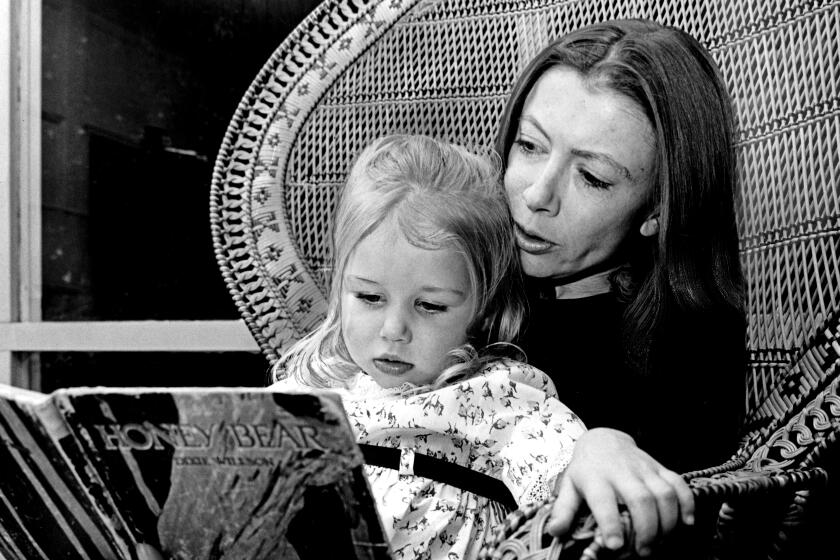BOOK REVIEW : Photographer Finds Freedom in Search for Polar Bears : THE CAGE <i> by Audrey Schulman</i> ; Algonquin Books; $17.95, 228 pages
- Share via
Rivaling love and war in durability, the theme of man against nature continues to tempt novelists. Recently, significant numbers of women have begun to turn up in the wilderness, encroaching upon a literary province once exclusively male.
Even so, the heroine of Audrey Schulman’s compelling adventure story seems an unlikely contender--a petite, shy photographer who has built a modest reputation with animal shots, mostly taken in the Boston Zoo. Beryl Findham is an eco-worrier; concerned about the population explosion, pollution, the ozone layer and endangered species, as well as an assortment of more subtle threats to the future of the planet. Wary of entanglements, she’s unattached and uncommitted, outwardly content with her quiet, intensely private life.
We meet her in the closet of her apartment, where she’s sitting in the dark holding an ice cube in her hand, attempting to project herself into the Canadian tundra where the temperature hovers around 40 below zero. The closet is meant to simulate the metal cage in which she’ll be confined while she takes close-ups of polar bears. Beryl has just been hired as the still photographer for Natural Photography, a prestigious magazine that prides itself upon avoiding tricks of the trade, such as zoom lenses and darkroom manipulations.
A fine photographer, Beryl knows she’s gotten the assignment primarily because--at 5 feet, 1 inch--she’s the only applicant who can fit in the cage, which turned out to be somewhat smaller than planned. She will be the only woman on the expedition, and she’s looking forward to a fantastic adventure, a welcome change from her humdrum urban life.
Boarding the plane from Winnipeg to Churchill, Manitoba, Beryl meets Dave Golding, the video cameraman who looks “like an elf who shopped in SoHo.” Dave is clever, witty and garrulous, in striking contrast to the other expedition member, a taciturn man who introduces himself merely as Butler, the naturalist who will write the accompanying story.
On one of their preliminary explorations to the local dump, where the famished bears gather before setting off for their seal hunting grounds on Hudson Bay, the group sees 13 foraging bears.
“The bears seemed to be willing to give anything a try as food, eating the foam rubber out of couches, tugging the seats off snowmobiles, chewing on vinyl car roofs. Standing up in the van, Beryl saw one bear sniffing a closed can of paint, putting his teeth to each edge, curling his lips back, then turning the can over to try again. Each time the bears found something they considered edible, they looked content, chewing hard, strings of drool rolling from their mouths.”
Beryl’s expedition will follow the bears to their destination at Cape Churchill. Impatient and eager to learn more about what’s in store for her, she fills the down time before they leave by joining Deputy Maggie Johnson on her nightly rounds. Maggie is an emigre from Atlanta who not only patrols the streets alerting residents to the presence of bears, but puts some additional feminist spin on the novel.
Once the party has arrived at its destination 40 miles from town, the pace and tension dramatically accelerate. In comparison to the frozen tundra, Churchill is Paris. The vehicle proves no match for the bears, who munch through the space-age materials of the undercarriage and leave the party stranded without heat, fuel or power.
From this point on, the story becomes almost unbearably suspenseful and horrific, calculated to freeze your blood even as you read it on a sunny California beach. You’ll never hear “bear” and think of Winnie-the-Pooh again.
In hallowed person-against-nature tradition, the tale is weighted with symbolism; the cage a metaphor for the limitations of Beryl’s prior life and the characters representing various attitudes toward the powers of nature.
The author’s style, at once terse and lyrical, refreshes and enhances the proven formula. Her appealing heroine is a true original, transformed emotionally and physically by experiences marvelously imagined and unforgettably described.
More to Read
Sign up for our Book Club newsletter
Get the latest news, events and more from the Los Angeles Times Book Club, and help us get L.A. reading and talking.
You may occasionally receive promotional content from the Los Angeles Times.










